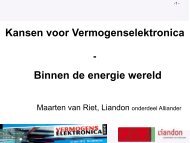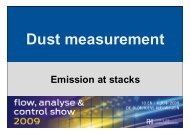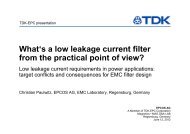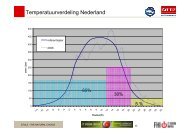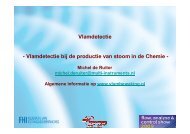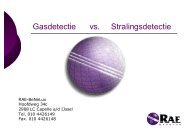AECTP-200-EDIT/4
AECTP-200-EDIT/4
AECTP-200-EDIT/4
You also want an ePaper? Increase the reach of your titles
YUMPU automatically turns print PDFs into web optimized ePapers that Google loves.
DMS 1722306
<strong>AECTP</strong>-<strong>200</strong><br />
(Edition 4)<br />
<strong>AECTP</strong>-<strong>200</strong><br />
ENVIRONMENTAL CONDITIONS<br />
May <strong>200</strong>9<br />
i<br />
ORIGINAL
NORTH ATLANTIC TREATY ORGANIZATION<br />
NATO STANDARDIZATION AGENCY<br />
NATO LETTER OF PROMULGATION<br />
7 May <strong>200</strong>9<br />
1. <strong>AECTP</strong>-<strong>200</strong> (Edition 4) - ENVIRONMENTAL CONDITIONS is a non-classified<br />
NATO publication. The Agreement of Nations to use this publication is recorded in<br />
STANAG 4370.<br />
2. <strong>AECTP</strong>-<strong>200</strong>(Edition 4) is effective upon receipt. It supersedes <strong>AECTP</strong>-<strong>200</strong><br />
Edition 3 which shall be destroyed in accordance with local procedures for the<br />
destruction of documents.<br />
~--~;:::JJ,v~O-R-EN-O------<br />
dmiral, ESP(N)<br />
or, NATO Standardization Agency
<strong>AECTP</strong>-<strong>200</strong><br />
(Edition 4)<br />
ALLIED ENVIRONMENTAL CONDITIONS AND TEST PUBLICATIONS<br />
<strong>AECTP</strong>-<strong>200</strong> – Comprising 230,240,250<br />
ENVIRONMENTAL CONDITIONS<br />
<strong>AECTP</strong>-<strong>200</strong> is one of five documents included in STANAG 4370. It provides characteristics and<br />
data on environmental conditions for operational events and scenarios that influence the design of<br />
defence materiel. Although it is not practicable to provide data to cover all circumstances, <strong>AECTP</strong>-<br />
<strong>200</strong> is considered to include the most relevant environmental conditions.<br />
<strong>AECTP</strong>-<strong>200</strong> comprises of <strong>AECTP</strong>-230 series of leaflets on Climatic Conditions, <strong>AECTP</strong>-240 series<br />
of leaflets on Mechanical Conditions and <strong>AECTP</strong>-250 series of leaflets on<br />
Electrical/Electromagnetic Conditions.<br />
<strong>AECTP</strong>-<strong>200</strong> is to be used in conjunction with the four other <strong>AECTP</strong>s included in STANAG 4370.<br />
They are: <strong>AECTP</strong>-100 Environmental Guidelines for Defence Materiel, <strong>AECTP</strong>-300 Climatic<br />
Environmental Tests, <strong>AECTP</strong>-400 Mechanical Environmental Tests, and <strong>AECTP</strong>-500 Electrical<br />
Environmental Tests.<br />
An important application of <strong>AECTP</strong>-<strong>200</strong> is for users to confirm that the key environmental<br />
conditions within project specific environmental requirement documents have been addressed<br />
correctly. In particular, when used in conjunction with the other <strong>AECTP</strong>s, the environmental<br />
characteristics and data contained in <strong>AECTP</strong>-<strong>200</strong> should facilitate the development of a<br />
comprehensive and cost effective set of environmental tests and assessments.<br />
The data presented in <strong>AECTP</strong>-<strong>200</strong> are intended for use during the specification process but also<br />
are to be considered when extended life is under focus. Refer to <strong>AECTP</strong>-600 for guidance.<br />
When possible, the use of measured data to develop test severities is recommended. For many<br />
environment conditions <strong>AECTP</strong>-<strong>200</strong> provides advice on the derivation of test levels from measured<br />
data.<br />
<strong>AECTP</strong>-<strong>200</strong> does not address abnormal environments arising from accidental or hostile conditions,<br />
or nuclear effects.<br />
iii<br />
ORIGINAL
<strong>AECTP</strong>-<strong>200</strong><br />
(Edition 4)<br />
ENVIRONMENTAL CONDITIONS<br />
TABLE OF CONTENTS<br />
<strong>AECTP</strong><br />
TITLE<br />
<strong>200</strong> INTRODUCTION<br />
<strong>200</strong> RELATED SOURCES OF INFORMATION<br />
230 CLIMATIC CONDITIONS<br />
240 MECHANICAL CONDITIONS<br />
250 ELECTRICAL/ELECTROMAGNETIC CONDITIONS<br />
iv<br />
ORIGINAL
<strong>AECTP</strong>-<strong>200</strong><br />
(Edition 4)<br />
INTRODUCTION<br />
1. PURPOSE<br />
1.1 The purpose of <strong>AECTP</strong>-<strong>200</strong> is to provide characteristics and data on climatic, mechanical<br />
and electrical/electromagnetic environments, and also guidance on the application of the<br />
data.<br />
2. SCOPE<br />
2.1 <strong>AECTP</strong>-<strong>200</strong> describes environmental conditions and data that have been compiled from<br />
established sources within NATO countries. Where possible the potential damaging effects<br />
of these conditions on defence materiel are also identified. Advice is given on the selection of<br />
suitable test methods. For mechanical conditions, guidance is also given on the<br />
determination and validation of environmental test severities from actual measured data.<br />
2.2 <strong>AECTP</strong>-<strong>200</strong> does not address environments arising from accident or hostile conditions, or<br />
nuclear effects.<br />
2.3 The purpose of the <strong>AECTP</strong>-230 series of leaflets is to present characteristics and data<br />
samples of natural and induced climatic conditions that influence the design of materiel. For<br />
the purpose of this document, induced climatic conditions are the ambient environmental<br />
conditions resulting from the modification of the natural climatic conditions due to the<br />
structure in which, or on which, the materiel is utilised.<br />
2.4 The purpose of the <strong>AECTP</strong>-240 series of leaflets is to present characteristics, data samples<br />
and sources for mechanical conditions, particularly vibration and shock that influence the<br />
design of defence materiel. The information is amplified and extended by the identification of<br />
potential damaging effects of these conditions on defence materiel and also by providing<br />
advice on the selection of suitable test methods. Guidance is also given on the determination<br />
and validation of environmental test severities from actual measured data.<br />
2.5 The environmental conditions within the <strong>AECTP</strong>-250 series of leaflets are under<br />
development and it is intended that they will be included in a subsequent edition of this<br />
<strong>AECTP</strong>. The structure and contents of 250 will be in a similar form to those of 230 and 240.<br />
3. APPLICATION<br />
3.1 The characteristics and data contained in <strong>AECTP</strong>-<strong>200</strong> should be used, where possible, in the<br />
preparation of national requirement documents for defence materiel to be procured for NATO<br />
forces. It should be used in conjunction with measured data for deriving the appropriate<br />
conditions for specific defence materiel and as the basis for determining environmental<br />
design and test criteria.<br />
1<br />
ORIGINAL
<strong>AECTP</strong>-<strong>200</strong><br />
(Edition 4)<br />
RELATED SOURCES OF INFORMATION<br />
INTRODUCTION<br />
1. This document comprises sets of document references. The documents are<br />
considered to contain related sources of information and data to that included<br />
in <strong>AECTP</strong>-<strong>200</strong>. The content of these documents provides, in particular<br />
applications, additional material to that in <strong>AECTP</strong>-<strong>200</strong> that might be of benefit<br />
when compiling environmental descriptions and test specifications.<br />
2. The references to the documents have been submitted by the members of the<br />
Task Group on Environmental Conditions and Test Procedures and are<br />
grouped according to their country of origin. NATO references are listed first.<br />
The references will be reviewed and appropriate additional references will be<br />
included in future editions of this <strong>AECTP</strong>.<br />
NATO<br />
1. Allied Administrative Publications 6 (AAP-6) "NATO Glossary of Terms and<br />
Definitions".<br />
2. "Glossary of Terms and Definitions for general use within AC/310".<br />
3. STANAG 4242 - Vibration Tests for Munitions Carried in Tracked Vehicles.<br />
4. Allied Environmental Conditions Publication 1 (AECP-1) "Mechanical<br />
Environmental Conditions".<br />
FRANCE<br />
1. GAM-EG-13 Basic Environmental Test Procedures + Annexes.<br />
Custodian:<br />
Laboratoire de Recherches Balistiques et Aérodynamiques<br />
2. CIN-EG01 Guidelines for Accounting for the Environment in Military<br />
Programmes<br />
Custodian:<br />
Laboratoire de Recherches Balistiques et Aérodynamiques<br />
2<br />
ORIGINAL
<strong>AECTP</strong>-<strong>200</strong><br />
(Edition 4)<br />
GERMANY<br />
1. Bauvorschrift fuer Schiffe der Bundeswehr: BV 0430 Schocksicherheit<br />
BV 0440 Vibrationssicherheit<br />
Custodian: BWB - PAS 90<br />
Comment:<br />
This document is included to cover the needs of the German<br />
Navy.<br />
UNITED KINGDOM<br />
1. Defence Standard 00-35 Environmental Handbook for Defence Materiel.<br />
Custodian:<br />
Defence Ordnance Safety Group, Ministry of Defence<br />
UNITED STATES<br />
1. Military Standard 810 Department of Defence Test Method Standard for<br />
Environmental Engineering Considerations and Laboratory Tests.<br />
Custodian:<br />
US Army Developmental Test Command<br />
2. IES Recommended Practice 012.1 - Handbook Dynamic Data Acquisition and<br />
Analysis<br />
Custodian:<br />
Institute of Environmental Sciences and Technology<br />
3. International Test Operations Procedure (ITOP) 1-2-601 – Laboratory<br />
Vibration Schedules.<br />
Custodian:<br />
US Army Developmental Test Command<br />
4. International Test Operations Procedure (ITOP) 1-1-050 - Development of<br />
Laboratory Vibration Test Schedules.<br />
Custodian:<br />
US Army Developmental Test Command<br />
3<br />
ORIGINAL




